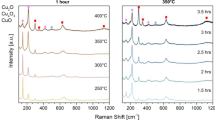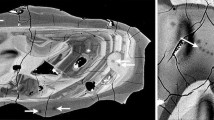Abstract
Cu samples were irradiated with 10 MeV Au3+ ions at 200 °C to damage levels of 5, 10, and 15 displacements per atom (dpa) as an analogue to study long term self-irradiation effects of alpha-decay in Pu. Samples were then subject to accelerated aging at 350 °C for 1 h in air resulting in mixed oxide layer growth (Cu2O and CuO). Raman spectroscopy revealed that the CuO phase fraction was gradually decreased as the damage level increased. These findings indicate that accumulated damage from self-irradiation causes quantifiable modifications in metal oxidation that could serve as a novel forensic signature.






Similar content being viewed by others
References
Atomic Energy Act of 1954 (P.L. 83–703)
U.S. Dept. of Defense (2018) Nuclear posture review report. Washington, DC
Hecker S (2000) Aging of plutonium and its alloys. Los Alamos Sci 26:238–243
Haschke J (2000) Surface and corrosion chemistry of plutonium. Los Alamos Sci 26:252–273
Baclet N (2002) Self-irradiation effects in plutonium alloys stabilized in the δ-phase. J Nucl Sci Technol 39(3):148–151
Mathew K (2019) Intercomparison of the radio-chronometric ages of plutonium-certified reference materials with distinct isotopic compositions. Anal Chem 91:11643–11652
Fitzgerald R (2016) How Old Is It? - 241Pu/241Am nuclear forensic chronology reference materials. J Radioanal Nucl Chem 307(3):2521–2528
Pommé S (2014) Uncertainty propagation in nuclear forensics. Appl Radiat Isot 89:58–64
Stanley F (2013) A brief introduction to analytical methods in nuclear forensics. J Radioanal Nucl Chem 295:1385–1393
Kemp R (2016) Physical cryptographic verification of nuclear warheads. Proc Natl Acad Sci USA 113(31):8618–8623
Westgate J (1997) Fission-track dating. Chronometric dating in archaeology, vol 2. pp 127–158
Gleadow A (1981) Fission-track dating methods: What are the real alternatives? Nucl Tracks 5:1–2:3–14
Chung B (2015) Effects of self-irradiation in plutonium alloys. J Nucl Mater 471:239–242
Stakebake J (1977) The high temperature oxidation of Plutonium-3.3 a/o gallium. ECS J Solid State Sci Technol 124(3):460–465
Narayan J (1977) Ion radiation damage in copper. J Nucl Mater 71(1):160–170
Zinkle S (1994) Defect microstructure in copper alloys irradiated with 750 MeV protons. J Nucl Mater 212–215(1):132–138
Singh B (1993) Defect accumulation in pure fcc metals in the transient regime: a review. J Nucl Mater 206(2–3):212–229
Avdeeva A (2015) The kinetics of point defects in metals under ion irradiation. J Phys Conf Ser 653:012028
Choudhary S (2018) Oxidation mechanism of thin Cu films: a gateway towards the formation of single oxide phase. AIP Adv 8:055114
Garrison L (2015) The effects of tungsten’s pre-irradiation surface condition on helium-irradiated morphology. J Nucl Mater 466:302–311
Zhang Y (2014) New ion beam materials laboratory for materials modification and irradiation effects research. Nucl Instrum Methods Phys 338:19–30
Crespillo M (2016) In-situ luminescence monitoring of ion-induced damage evolution in SiO2 and Al2O3. J Lumin 172:208–218
Crespillo M (2016) Temperature measurements during high flux ion beam irradiations. Rev Sci 87:024902
Stoller R (2013) On the use of SRIM for computing radiation damage exposure. Nucl Instrum Methods Phys Res B Beam Interact with Mater Atoms 310:7580
Ziegler J (2010) SRIM—the stopping and range of ions in matter. Nucl Instrum Methods Phys Res B Beam Interact with Mater Atoms 268:11–12:1818–1823
Lang M (2015) Characterization of ion-induced radiation effects in nuclear materials using synchrotron X-ray techniques. J Mater Res 30:1366–1379
Prescher C (2015) DIOPTAS: a program for reduction of two-dimensional X-ray diffraction data and data exploration. High Press Res 35(3):223–230
Rietveld H (1969) A profile refinement method for nuclear and magnetic structures. J Appl Crystallogr 2(2):65–71
Toby B (2013) GSAS-II: the genesis of a modern open-source all purpose crystallography software package. J Appl Crystallogr 46(2):544–549
Birtcher R (1981) Damage saturation effects on volume and resistivity changes induced by fission-fragment irradation of copper. J Nucl Mater 98(1–2):63–70
Larson B (1974) High-precision measurements of lattice parameter changes in neutron-irradiated copper. J Appl Phys 45:514
Zinkle S (1986) Microstructure of copper following high dose 14-MeV Cu ion irradiation. J Nucl Mater 138(1):46–56
Daulton T (1997) Transmission electron microscopy study in-situ of radiation-induced defects in copper at elevated temperatures. In: Materials Research Society Symposium Proceedings, vol 439
Sun C (2014) In situ study of defect migration kinetics in nanoporous Ag with enhanced radiation tolerance. Sci Rep 4:3737
Ebisuzaki Y (1985) Oxidation Kinetics of Copper. J Chem Educ 62(4):341–343
Gulbransen E (1961) Oxidation of Copper between 250 °C and 450 °C and the Growth of CuO ‘Whiskers’. J Electro Soc 108(2):119–123
Jae Won L (2006) Brief review of oxidation kinetics of copper at 350 °C to 1050 °C.. Metall Mater Trans A 37:1231–1237
Korzhavyi P (2011) Literature review on the properties of cuprous oxide Cu2O and the process of copper oxidation. Swedish Nuclear Fuel and Waste Management Co. Internal Report. TR-11-08
Pike J (2006) Formation of stable Cu2O from reduction of CuO nanoparticles. Appl Catal 303:273–277
Sander T (2014) Correlation of intrinsic point defects and the Raman modes of cuprous oxide. Phys Rev B 90:045203
Miranda R (1984) Invited Review: Influence of ion radiation damage on surface reactivity. Vacuum 34:12:1069–1079
Florez R (2020) Early stage oxidation of ZrC under 10 MeV Au3+ ion-irradiation at 800 °C. Corros Sci 169:108609
Florez R (2020) The irradiation response of ZrC ceramics under 10 MeV Au3+ ion irradiation at 800 °C. J Eur Ceram Soc 40:5:1791–1800
Colas-Leroux K (2016) Microstructure evolution in ion irradiated oxidized Zircaloy-4 studied with synchrotron radiation micro-diffraction and transmission electron microscopy. In: 18th international symposium on zirconium in the nuclear industry. Hilton Head, United States
Hoang N (2019) Strain-dependent structure and and Raman behaviours in the heavy-ion irradiated manganite at extreme low dose. Sci Rep 9:19204
Gautam S (2014) Micro-Raman study on the softening and stiffening of phonons in rutile titanium dioxide film: competing effects of structural defects, crystallite size, and lattice strain. J Appl Phys 115:143504
Hagemann H (1990) Raman spectra of single crystal CuO. Solid State Commun 73:6:447–451
Levitskii V (2015) Raman spectroscopy of copper oxide film deposited by reactive magnetron sputtering. Tech Phys Lett 41:11:1094–1096
Zheng Y (2012) In-situ Raman monitoring of stress evaluation and reaction in Cu2O oxide layer. Mater Lett 78:11–13
Hong B (2007) Influence of complexing agents on texture formation of electrodeposited copper. Surf Coat Tech 201:16–17:7449–7452
Zhou G (2003) Initial oxidation kinetics of copper (110) film investigated by in situ UHV-TEM. Surf Sci 531:359–367
Bolse T (2006) Swift heavy ion induced dewetting of metal oxide thin films on silicon. Nucl Instrum Methods Phys Res B 245:264–268
Boon A (1992) Influence of surface oxygen vacancies on the catalytic activity of copper oxide, Part 1: oxidation of carbon monoxide. J Mol Catal 75:277–291
Acknowledgements
This work was supported by the U.S. Department of Homeland Security (DHS) Domestic Nuclear Detection Office (DNDO) Academic Research Initiative (ARI) under Grant 2015-DN-077-ARI093. The views presented in this paper are those of the authors do not necessarily reflect those of U.S. Dept. of Homeland Security (DHS), DNDO, or the ARI. J.L.B and WFC were funded by an Integrated University Program Graduate Fellowship. M.L.C. acknowledges support from the University of Tennessee Governor’s Chair program. Portions of this work were performed at HPCAT (Sector 16), Advanced Photon Source (APS), Argonne National Laboratory. HPCAT operations are supported by DOE-NNSA’s Office of Experimental Sciences. The Advanced Photon Source is a U.S. Department of Energy (DOE) Office of Science User Facility operated for the DOE Office of Science by Argonne National Laboratory under Contract No. DE-AC02-06CH11357. HPCAT beam time was provided by the Chicago/DOE Alliance Center. GIXRD was performed at the Joint Institute for Advanced Materials (JIAM) Diffraction Facility, located at the University of Tennessee, Knoxville. Finally, we thank Dr. Steven Zinkle for his comments and expertise. This work was reviewed and released under LA-UR-20-24516.
Author information
Authors and Affiliations
Corresponding author
Additional information
Publisher's Note
Springer Nature remains neutral with regard to jurisdictional claims in published maps and institutional affiliations.
Rights and permissions
About this article
Cite this article
Bishop, J.L., Cureton, W.F., Crespillo, M.L. et al. Radiation-induced modifications in copper oxide growth. J Radioanal Nucl Chem 327, 123–131 (2021). https://doi.org/10.1007/s10967-020-07486-x
Received:
Accepted:
Published:
Issue Date:
DOI: https://doi.org/10.1007/s10967-020-07486-x




